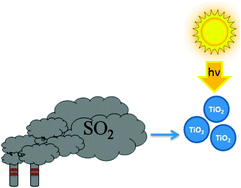Sulfur dioxide adsorption and photooxidation on isotopically-labeled titanium dioxide nanoparticle surfaces: roles of surface hydroxyl groups and adsorbed water in the formation and stability of adsorbed sulfite and sulfate†
Abstract
Transmission FTIR spectroscopy and X-ray photoelectron spectroscopy (XPS) are used to probe the details of sulfur dioxide adsorption and photooxidation on titanium dioxide nanoparticle surfaces. Adsorption sites, surface speciation and photooxidation chemistry have been determined from analysis of FTIR spectra in conjunction with isotope labeling experiments. These data show that surface hydroxyl groups are involved in the adsorption of sulfur dioxide, and in particularly, sulfur dioxide reacts with either one surface O–H group to yield adsorbed bisulfite or two surface O–H groups to yield adsorbed sulfite and water. Using 16O–H, 16O–D and 18O–H labeled surface O–H groups, additional insights into the adsorption mechanism as well as shifts in the vibrational modes of adsorbed sulfite have been determined. Upon irradiation, adsorbed sulfite/bisulfite converts to adsorbed sulfate. The relative stability of adsorbed sulfite to adsorbed sulfate on TiO2 nanoparticle surfaces was also examined in the presence of increasing relative humidity (RH). It is shown here that adsorbed water can more easily displace sulfite compared to sulfate by forming a stable sulfur dioxide water complex in the presence of adsorbed water. These differences in the RH-dependent stability of adsorbed species that form as a result of surface heterogeneous reactions on oxide particles surfaces has important implications in the heterogeneous chemistry of mineral dust aerosol in the atmosphere.


 Please wait while we load your content...
Please wait while we load your content...